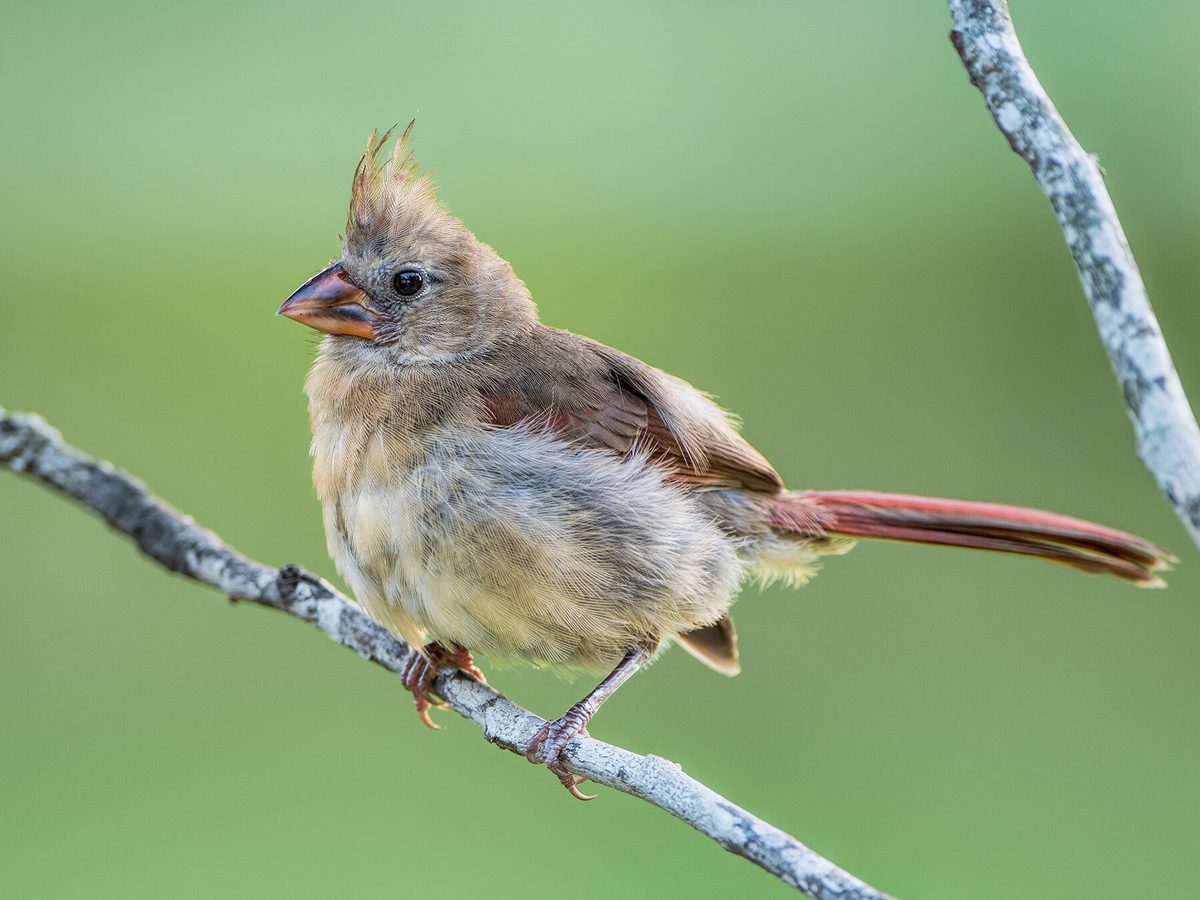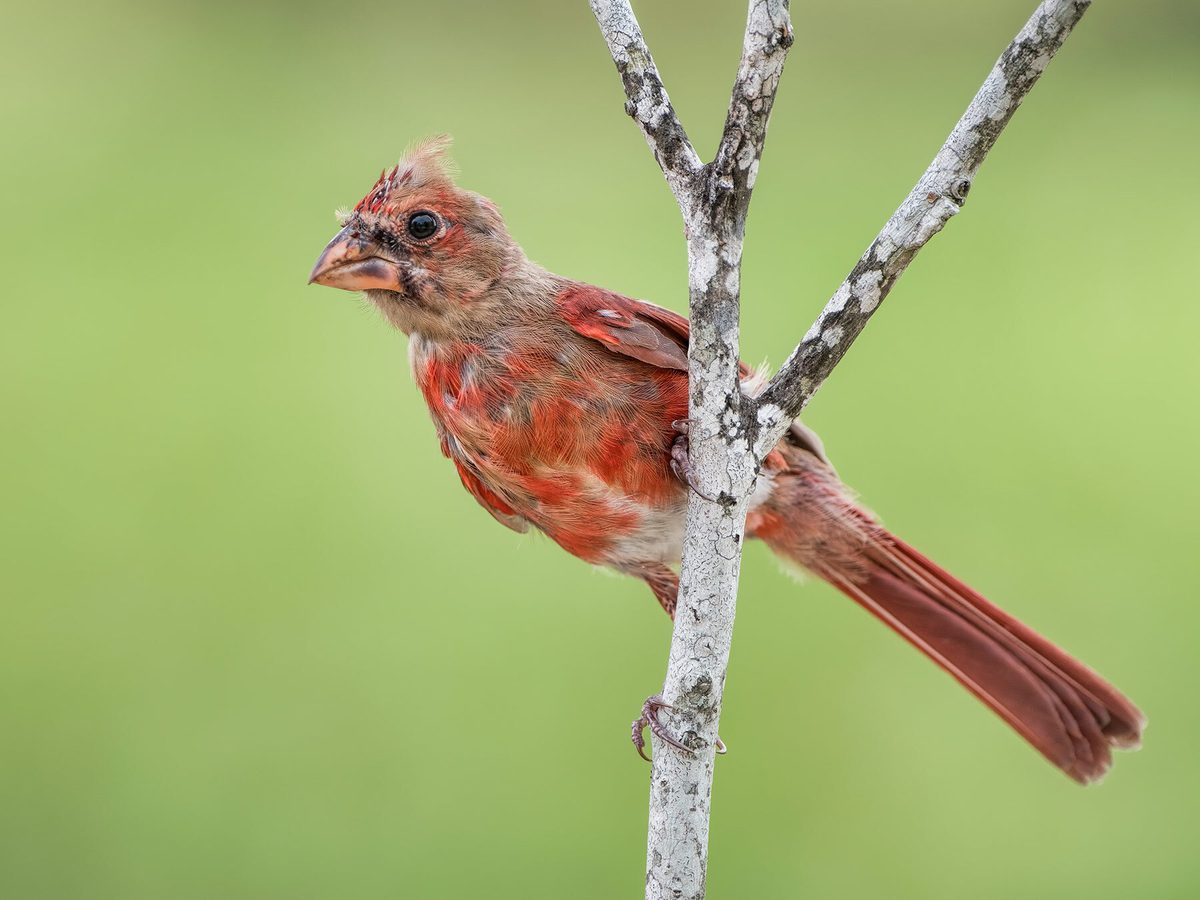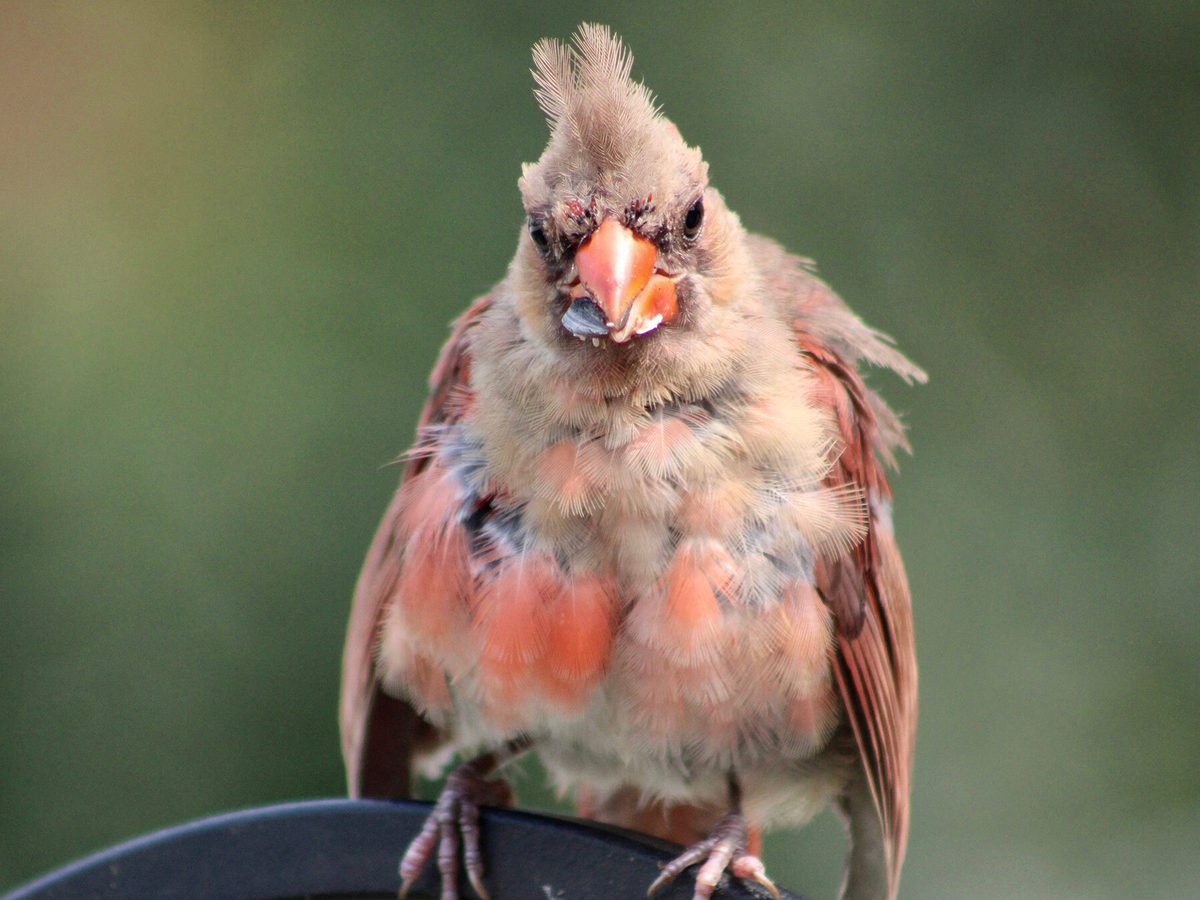Adult male northern cardinals (Cardinalis cardinalis) are instantly recognizable with their striking scarlet plumage, prominent crest, and contrasting black ‘face mask’ markings around their orange-red beak. Females are more subdued, with grayish-tan bodies, with some red patches throughout.
Keep reading to find out whether juvenile cardinals resemble their parents from an early stage, or whether they look entirely different until they reach maturity.
What do juvenile Cardinals look like?
Cardinal hatchlings are featherless until around 3 days of age, when the first feathers start to develop. Initial patches of gray down are gradually replaced with pin feathers on the wings, which quickly fill out into a patchy juvenile plumage of brown fluffy down, streaked with red by the time the bird is ready to fledge (at anything between 7 and 13 days). At this stage, their tails are also short and stubby and gradually become longer over the coming weeks.
A young cardinal’s crest develops between 10 days to 2 weeks after hatching and is typically present before any traces of the red adult plumage are visible.
Juvenile cardinals do not have the distinctive red-orange beak seen in adult birds until they are almost fully mature. On hatching, their beaks are grayish-black and they do not become the trademark orange-red color until they acquire their final adult plumage in the fall.

Cardinal fledgling on the first day out of the nest

Juvenile Female Cardinal
By the time they have fledged, juvenile cardinals are similar in size and shape to adults but lack the final fully red plumage until they undergo a major molt in October or November (around 6 to 7 months after the breeding season). Until then, both male and female juveniles are similar in coloring to adult female birds, with a buff-brown plumage, mottled with orange-red streaks.
By the time they enter their first winter, the majority of juvenile male and female cardinals have molted into their respective mature plumages and cannot be told apart from adult birds, although for juveniles from later broods may only undergo a partial molt at this stage and take slightly longer to fully transition.

Juvenile Male Northern Cardinal undergoing first molt
How big are juvenile cardinals?
Shortly after hatching, northern cardinals weigh just 3.5 g (0.12 oz) and are just a few centimeters in length.
Growth of nestlings is rapid, and by the time they reach 7 days they are much larger, weighing around 25 g (0.9 oz) and in some cases may even be ready to fledge.
Still slightly smaller than adult birds, with stumpy tails and shorter wings at this stage, by between two and four weeks they reach the same size as adult birds.

Northern Cardinal (Cardinalis cardinalis) male feeding juvenile
When do juvenile Cardinals molt?
Juvenile cardinals undergo a significant molt of their first feathers in the fall, entering their first winter period with their recognizable red or brown adult plumage, depending on whether they are female or male.

Close up of a molting male Northern Cardinal juvenile feeding on seeds
Do juvenile Cardinals have black beaks?
In the early stages of its life, a juvenile northern cardinal’s beak is not the bright orange-red shade associated with that of an adult bird. On hatching, young cardinal chicks have grayish-black beaks. It is not until they undergo their molt in the fall that their bills become lighter and brighter, at the same time that their overall plumage changes to that of an adult bird.
What do juvenile Cardinals eat?
Cardinal chicks are fed in the nest by both parents, with males appearing to take the larger share of feeding duties. Food is passed from the parent’s beak, and may occasionally be regurgitated, but is mostly tiny insects that are eaten whole.
Young cardinals fledge when they are between 7 and 13 days old, most commonly between 9 and 10 days. For the first 11 days after fledging, parents continue to be the sole source of food, but gradually young birds learn to fend for themselves.
Parental feeding continues, with examples of birds up to 8 weeks after fledging receiving some feeds from the male (or less frequently the female) parent.
Despite being omnivorous birds, in the early stages, and particularly when parents are doing the bulk of feeding, insects, grubs and caterpillars represent the largest share of a juvenile cardinal’s diet.

A young Cardinal fledgling waiting to be fed by their parents
How long does Cardinal juvenile plumage last?
Juvenile cardinals undergo a molt in the fall after they leave the nest. Even the latest born chicks of the year (where the parents have had a second or possibly third brood of the season), will undergo this molt ahead of their first winter – either completely or in partial form.
The patchy, fluffy juvenile plumage is replaced with the distinctive red or red-streaked plumage of adult males and females within the first year of their life, or in most cases, a lot sooner.

A pair of juvenile Cardinals bathing in a bird bath
How long do juvenile Cardinals stay with their parents?
After they have fledged, juvenile cardinals initially maintain a strong association with their parents, and rely on them for food for anything up to eight or even ten weeks after leaving the nest.
The bulk of the support comes from the male, as it is not unusual for the female to have already begun incubating a subsequent brood.
Eventually juveniles leave the parents’ territory, either by their own accord or they are driven away by their parents, who have by this point shifted their focus and time demands to raising a new brood of chicks.

Adult male (left) and female juvenile (right) Cardinals perched on a branch
Will juvenile cardinals visit their parents?
Once juveniles have left their hatch territory, they will likely stay in the same general area, but may also venture further afield and join a flock or communal roost with other juvenile birds.
It is not uncommon for juveniles to remain part of the same loose flock as their parents through the first year before they are ready to establish their own breeding territories.

Juvenile male Northern Cardinal starting to show distinct bright red plumage
How old are juvenile cardinals when they reach maturity?
Juvenile male and female cardinals both reach sexual maturity when they are one year old, and successful breeding can take place from this point onwards.
However, around 60 to 85 percent of nests fail, with nestlings having an especially high mortality rate: only around half of all young cardinals will make it to adulthood.
